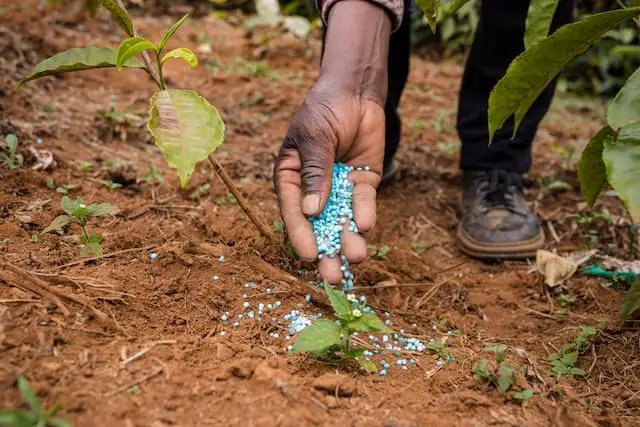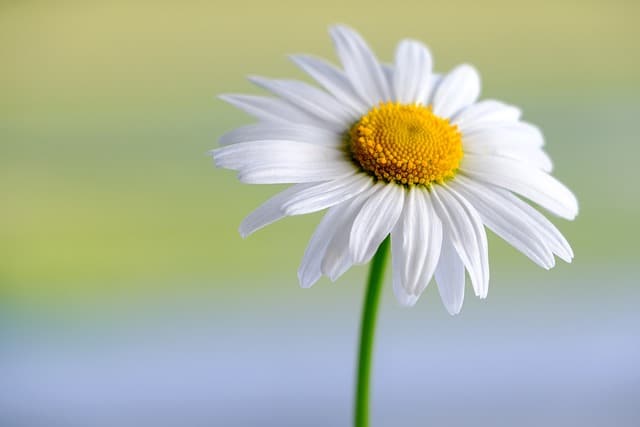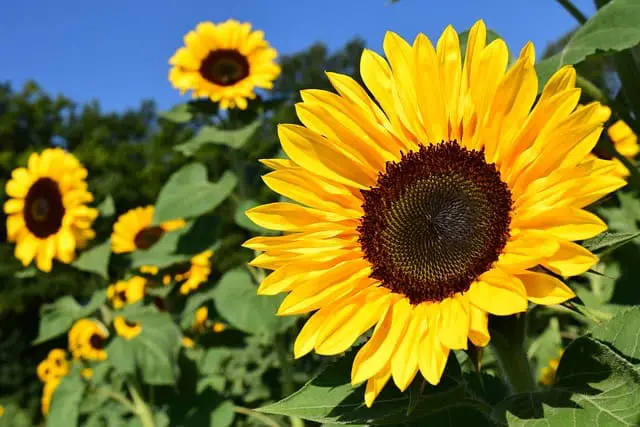While all flowers are attractive, sunflowers and daisies are among the most gorgeous in the world. These two pretty flowers are widely grown in North and South America, and both flowers reach their peak blooming period during late spring or early summer.
If you want to know more about their similarities and differences, read on!
Sunflower vs Daisy

Sunflowers and daisies belong to the same family, which gives them many similar features. However, they have some differences between them. Besides the unique appearance of these plants, daisy does not produce seeds as opposed to sunflowers.
Moreover, you may grow daisies twice a year, whereas sunflowers are annual plants. Let’s tell you more similarities and differences between sunflowers and daisies in detail!
Comparison
| Sunflower | Daisy | |
| Leaf Color | Dull Green | Dark Green |
| Stem Color | Green or Dark red purple | Green |
| Variegation | Helianthus Annuus ‘Sunspots’ | Felicia Amelloides ‘Variegata’ |
| Flower | Cream, gold, orange, yellow, red, brown, and mahogany | Yellow, pink, burgundy, white, and orange |
Other similar comparisons:
Sunflower vs Daisy Differences
People often confuse daisies and sunflowers to be similar plants. However, even though they belong to the same family of Asteraceae, they lie in different genera. Because of this, their propagation and growth also differ slightly. Here’s how these plants are different from each other.
1. Origin and Name
Sunflower comes from the Greek word Helianthus. ‘Helios’ means sun, and ‘Anthos’ means flower. Thus, the name became sunflower over time.
Whereas daisy comes from an old English word daegeseage, which means ‘the days eye.’ This word represents the nature of this flower. It means that it opens in the daylight and closes at night.
2. Taxonomy
Sunflowers belong to the Asteraceae family and Helianthus genus. The scientific name for the sunflower is Helianthus annuus. The Helianthus genus contains 70 species of annual and perennial flowering plants besides sunflowers.
Bellis perennis, commonly known as daisy, is also a part of the Asteraceae family. It belongs to the Bellis genus. In Latin, Bellis means ‘pretty’ and perennis means ‘everlasting’.
3. Shape & Appearance
The sunflower plant has a tall, thick stem with hairs, containing a large flower head on the top. The stem has broad lower leaves arranged alternately. Sunflowers come in many colors but their iconic yellow-colored petals are their defining feature.
Daisies have a single stem and dark green rounded leaves with a pretty flower on the top having numerous petals. Daises can often be confused with pretty weeds but it’s good to know the difference between daisies and weeds.
4. Differences in Color

While yellow sunflowers are most commonly seen, you can find them in various other colors. Orange, red, cream, gold, white, and chocolate brown sunflowers are widely found. You may also see mahogany and pink sunflowers.
Daisies have a big spectrum of color, they can be found in yellow, pink, white, orange, and burgundy color.
5. Leaf Size and Texture
Leaves on the sunflower plant are arranged alternately, with new leaves arranged opposite at the base of the plant. The leaves are simple, triangular, or cardinal with serrated margins. The leaves are 3-12 inches in length, having hairs on both sides.
The daisy flower possesses multiple spoon-shaped leaves around its base. The leaves are hairy similar to sunflower leaves but form a rosette.
6. Height and Growth Rate
Sunflowers are typically tall plants ranging between 6ft to 15ft, depending on their variety. They can grow beyond 15ft if the conditions are right.
On the other hand, daisies are not tall plants, with dwarf daisies growing to 12 inches at most and full-sized varieties reaching a height of 30 inches. The bigger plants may develop a few inches per week.
7. Flowers
Sunflowers have a beautiful appearance mimicking the look of the gigantic sun. Their petals are often known as rays with multiple tiny disk florets in the center. The florets each comprise five tiny dark petals.
Daisies have vibrant, star-shaped heads with clusters of small flowers around a center disk of black or yellow florets. Daisies typically have 15 to 30 petals in each flower.
8. Growing Conditions, Temperature, and Climate
Sunflowers prefer moderate temperatures between 25°C and 28°C. However, they may tolerate a vast range of temperatures from -4°C to 34°C. They can bear hotter climates as long as their humidity needs are met.
Alternatively, daisies are more of cooler climate plants and prefer 15°C for flowering. Yet, temperatures between 21°C and 24°C are preferred for seed germination. They can tolerate temperatures between 5°C to 40°C
9. Light, Water, Soil

Sunflowers require full sun for around 6 to 8 hours every day to bloom properly. They grow quickly in moist, well-drained soil with organic matter to obtain nutrients. They easily grow in pH 6 to 7.5. They need to be watered once a week during their growing phase.
Daisies require rich and fast-draining healthy soil with plentiful watering and sunshine. It is best to use a mix of sand, manure compost, and peat moss. Besides proper sunlight and watering, slightly acidic to neutral soil (pH 6.0 to 8.0) helps daisies grow adequately.
10. Lifespan
Sunflowers are annual plants, while daisies are perennial plants. This means daisies have a longer lifespan than sunflowers. Being annual plants, sunflowers complete their cycle in a year. They develop from seeds, mature, produce flowers and seeds, and then die within a season.
Factors that influence the sunflower’s lifespan include its species, growing conditions, and environmental factors. Regardless, the average lifespan of the sunflowers is usually between 2 and 3 months. Hence, they need to be planted again the next season to continue their cycle. However, some species may not reach this stage, and some may exceed it.
On the contrary, daisies can live for up to 3–5 years, depending on the species. They produce leaves, stems, and roots within the first year. After producing flowers and seeds, the daisy plants die off. But in the following year, the plant will begin to grow again from its roots and produce flowers.
Sunflower vs Daisy Similarities
There are many similarities between sunflowers and daisies. The first similarity between these two flowers is that they both come from the family of Asteraceae. They require direct exposure to the sun, as their growth depends on the rays from the sun.
If they do not get the proper sunlight, both plants can die. Keep reading to know more similarities between sunflowers and daisies.
1. Sunlight
Sunflowers and daisies require full, bright sun to grow properly and maintain their leaf color. Both plants thrive best when provided with 6 to 8 hours of direct sunlight.
2. Watering
These plants do not require daily watering, yet it is important to keep them moist. Thus, it is recommended to water them every other week. You may also water them every week if you see the roots drying. Make sure to water them generously.
3. Potting and Soil
Make sure to plant sunflowers and daisies in areas with enough sun exposure. Provide them with nutrient-rich, well-draining soil, which should not be too compact. Both plants do well near neutral pH ranging between 6.0 and 8.0.
4. Fertilizer

Daisies and sunflowers do not generally require fertilizers. However, you may add a phosphorus-rich fertilizer to facilitate the growth of these plants.
5. Natural Habitat
These plants are widespread in open areas with an adequate water supply and ample sunlight. You may find them in grasslands, meadows, and gardens around you.
Common Problems for Both Plants
Despite being low-maintenance plants, they are also susceptible to parasitic diseases and damage to plants due to environmental factors. Immediate care can save your plants from deteriorating. Here are the common problems for daisies and sunflowers.
Sunflower Plant
Yellow Patches
Sunflowers are commonly susceptible to yellow patches and surface spots. It could be due to nitrogen deficiency, or spots on leaves may indicate overwatering.
Stem Rot
Another problem associated with sunflowers is the prevalence of Sclerotinia stem rot caused by white mold. It causes sudden wilting and cranking of the stem and head rot. Farmers try to avoid this disease through crop rotation. Don’t repeatedly grow your sunflowers in the same patch every year.
Daisy Plant

Fungal Diseases
Over-exposure to moisture can sometimes facilitate fungus growth, which may harm your daisies. Common fungal diseases that harm daisies include leaf spot fungus, cottony rot fungus, acremonium wilt, and root rot fungus.
The easiest way to deal with fungus is to use an anti-fungal spray. You can protect your plant against fungal infections by ensuring you do not overwater it.
Spider Mites
Spider mites are not the most common issue associated with daisies. Yet, it is always good to save your plants from them in case of infestation. Spider mites are difficult to detect.
However, they affect new flowers and damage them. Simple insecticides or soapy water sprays can deal with spider mites with ease.
Leaves Distortion by Aphids
Aphids often feed on various flowering plants, including daisies. Aphids feeding on your plants may affect the color of the leaves and turn them brown or yellow. They can also cause curling of leaves. Make sure to use a suitable insecticide for the aphids.
Weed Competition
Daisies are susceptible to competition from weeds, which results in stunted growth. Often, weeds take up the major needs of the daisies, including space, water, and nutrients. To get rid of them, apply mulch to the soil or pull out the weeds from the roots by hand. Also, consider using herbicides and creating enough space between the daisy plants.
Outro
Sunflowers and daisies are beautiful flowers belonging to the Helianthus genus. They bloom in bright sun, adequate water, and nutrition-rich soil. They are low-maintenance plants and grow in an open area with appropriate temperature and growth conditions. Both of these plants are excellent choices for anyone looking to grow beautiful flowers.
Frequently Asked Questions
Is sunflower easy to grow?
Sunflowers can tolerate heat and are easy to grow. The minimum sunlight exposure time required is 6 to 8 hours a day.
Apart from that, they are pest resistant and have a fast-growing nature. It takes around 3 to 4 months to develop before dropping seeds fully. Although they can grow in fertile soil, they can also perform well in containers.
Is Daisy easy to grow?
Like a sunflower plant, daisies are easy to grow since they depend on sunlight and have good heat tolerance. Due to their easy-to-grow nature, they are the most preferred plant to grow in gardens.
The growth of the seeds takes around 10 to 20 days whereas the flower will bloom the next year. If you want to grow this plant faster, apply an all-purpose fertilizer. The best place to raise a daisy is where there is direct exposure to the sun.
Do sunflowers and daisies go together?
Since they belong to the family of Asteraceae, they can be perfectly aligned with each other. Both plants have very similar soil, sunlight, and water requirements so you can easily grow them together.
They also accentuate each other since, in the language of flowers, sunflowers represent loyalty and adoration while daisies represent innocence and purity.

Hey, I’m Lisa and I’ve been an avid gardener for over 30 years. I love writing, talking and living in the garden! Feel free to connect with me on my socials below

